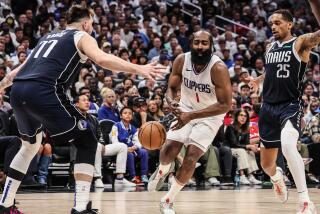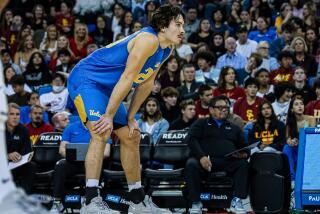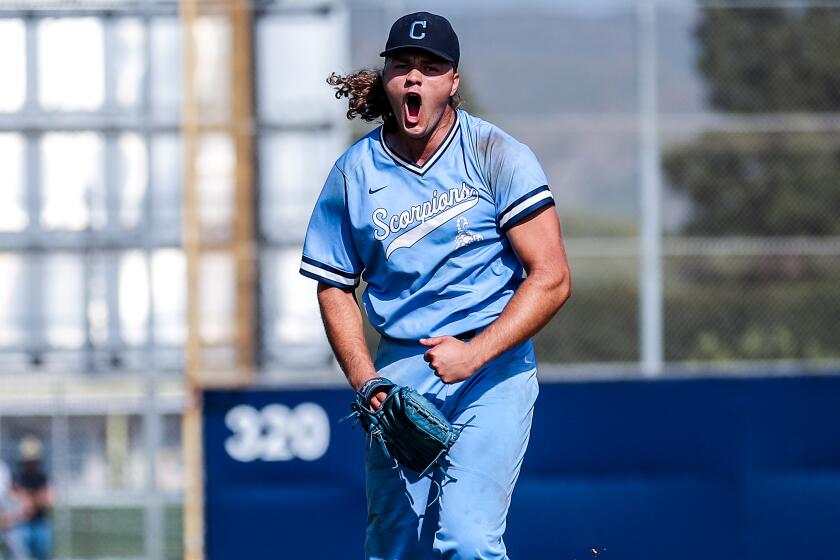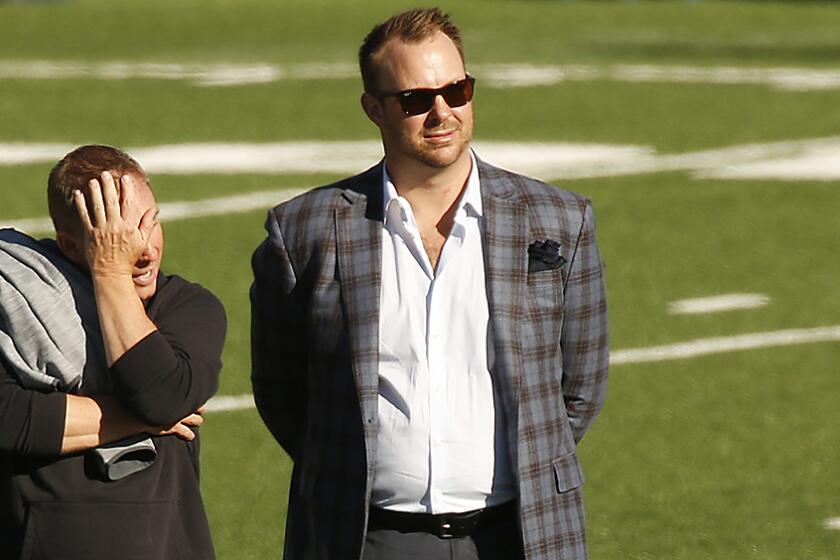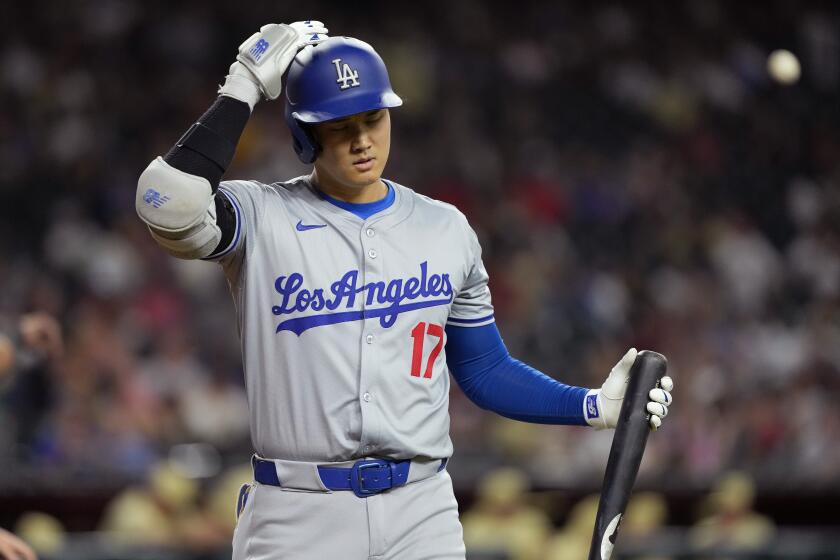Girl’s Death Rekindles Youth Football Debate
On a perfect football Sunday, two teams of 90-pound grade-schoolers gathered in the center of the field, held hands and, with fidgety awkwardness, bowed their heads.
“A moment of silence for No. 95, Taylor Davison,” the announcer said. “Rest in peace.”
Then the Bloomingdale Bears ran to their side of the field, the Bartlett Raiders to theirs. This was the first game day for this Raiders squad--full of Taylor’s friends from last season--since the impish 10-year-old blond died last Monday, apparently after suffering a head injury during practice. Her new team played its first game of the season as well Sunday.
After somber ceremonies before both games, the young players peered through their face masks, searching for their parents. They didn’t appear scared, but uncomfortable, perhaps.
“He wanted to know what the chances were of it happening to him,” Michele Kudalis said of her son Luke. “Who knows the odds? What do you say?”
In the first game, the Raiders took the kickoff and moved ahead only a few yards. A running play earned them a couple more. Everyone on both sides seemed nervous.
Then, in a moment that turned people’s minds back purely to football, Lucas Wantroba took a handoff, broke left, right and then free. He sprinted 48 yards and crossed the goal line to the kind of cheering unheard here in a week.
Later, when Taylor’s own squad (all 19 teams in the league are called the Raiders) finally scored against the Lombard Falcons, one Bartlett coach mumbled to a spectator: “It finally feels like I can breathe again.”
Because she was the only girl among 400 players in the league, Taylor’s death has prompted a number of questions and brought few answers--leaving the league and parents alike feeling besieged.
“Why doesn’t the media do human interest stories on this great, 30-year-old league with 400 football players and 400 cheerleaders? Why focus on this?” league President Barry Brinn asked just before game time Sunday. “Look at this beautiful day. Thousands and thousands of kids all over the place are playing football today.”
“A real spitfire,” as one parent called her Sunday, Taylor had taken a hard hit during a full-contact practice Aug. 27. She complained of a headache and sat out three plays, according to her coach, Ken Minarcik, before returning to the field.
Her mother, Susan Davison, has said that Taylor seemed fine and said nothing of having a headache over the next three days. At a light, no-contact practice Aug. 30, the girl again complained of a headache. She began walking to the sideline, handed her helmet to Minarcik, collapsed and vomited.
She died three days later of a subdural hematoma--a blood clot beneath the surface of the brain--that was caused by blunt trauma to the head, according to the Cook County medical examiner’s office.
The office said the hematoma appeared to have emerged five to 10 days before the girl died, but noted that its precise cause is unclear. More tests are planned.
Since Taylor’s death, some in this Chicago suburb of 37,000--and others around the country--have found themselves wondering whether children so small should be playing full-contact football.
Several National Football League stars, including quarterbacks Troy Aikman and Steve Young, have retired in recent years following repeated head injuries. Medical studies on football players have suggested that many concussions go undetected, and that players who suffer multiple head injuries have an increased chance of long-term declines in speech, memory and other brain functions.
Some have also asked whether girls may be especially susceptible to football-related injuries.
Susan Davison, who declined to comment for this story, defended the league immediately after her daughter’s death, saying Taylor not only loved the game but also played it so well that competitors quickly forgot about her gender.
Raiders teams are categorized by weight first and age second. Taylor played the last two years on teams with a 90-pound weight limit whose players cannot turn 11 before Sept. 1. Children weighing less than 80 pounds can play flag football, but not tackle, under the league’s rules.
A precocious Girl Scout who loved horseback riding and the country band Alabama, she played nearly every position on the team--from running back to nose tackle. Treated just like every other player, coaches say, she was nonetheless a rarity in a sport overwhelmingly populated by boys and men.
In fact, so few girls play football that there is not enough evidence to know whether a 10-year-old girl wearing a football helmet is more prone to a brain injury than a boy who endures a similar blow, said Mary Jo Kane, head of the Tucker Center for Research on Girls and Women in Sport. Thirty years after Title IX was enacted to try to bring financial equity to women’s collegiate sports, that is not the question to ask, Kane argued.
“We know that some sports, like football and boxing, are very dangerous,” Kane said. “But no one ever says men are not biologically equipped to participate. No matter how many Muhammad Alis, no matter how many Mark Buonicontis--who became a quadriplegic [while playing college football in 1985]--we never suggest that. When a girl gets hurt, that’s the first thing we talk about: Maybe girls shouldn’t be playing.
“The one thing I hope is that this accident doesn’t scare other girls who want to play football,” Kane continued. “The risk isn’t about being a girl, it’s about playing a risky sport.”
That is precisely what it was about Sunday at the perfectly groomed Ruzicka Park, 35 miles west of Chicago.
At the entrance stood a giant water bottle containing dollar bills and some change, along with a hand-lettered sign: “Taylor Davison Memorial Fund.”
The Raiders players on both squads wore their traditional black-and-silver uniforms, but with a new patch that reads simply “95” sewn next to the one with the skull and crossbones.
There was the moment of silence. A few parents crossed themselves. Taylor’s helmet sat on the bleachers. The specter of death seemed everywhere.
So was the sense of excitement created by dozens of children, their cleats laced up tight and eye-black smeared on just like the pros, taking to the field on a cloudless late-summer day.
“It’s always going to be in the back of our minds,” Lisa Wantroba said of Taylor’s death. “Always, always, always.”
Then her son Lucas, the one who ran in for that first, thrilling touchdown of the day, was lighting out again. Bloomingdale Bears were falling at his feet, and the Raiders were on their way to a 13-0 victory. The other Raiders team would eke out a 2-0 win.
“Go!” Lisa Wantroba shouted, her hands forming a bullhorn around her mouth. “Go!”
More to Read
Get our high school sports newsletter
Prep Rally is devoted to the SoCal high school sports experience, bringing you scores, stories and a behind-the-scenes look at what makes prep sports so popular.
You may occasionally receive promotional content from the Los Angeles Times.
